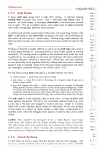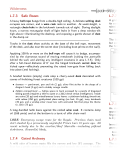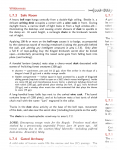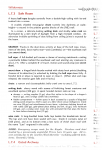squeen
8, 8, I forget what is for
How about if non-essential background info is just presented in the body of the text but with an earmarked "Lore" heading (or sidebar box)? That way, the DM knows quickly which text can be skipped while scanning during play. It allows for localization of data too...but I think some sort or "Lore Guide" in the Appendix would be an index of all those local items, arranged by subject matter, would be a necessity.
Of course, restraint in the frequency and length of the Lore would need to be exercised.
Here's a sample of what I'm playing with right now for my own content write-ups. It's fun trying to be a good "Bryce-ian", although I know it's probably way too long for his tastes (a 1/2 column for essentially an empty room). It's from the Storm Drains beneath the Royal Palace, and it specifically trying for a skulking-around/exploration focus.

1) Everything above the horizontal line is "just the facts". It's what (if you've ever read Heinlein's Stranger in a Strange Land) a Fair Witness would report---totally non-subjective without inference, and with an added effort to report the most immediately obvious stuff first. It's not read-aloud per-se, but its all "safe" to convey (except for the parenthetical info).
The second paragraph is "What Sherlock Holmes would notice".
2) Below the divider, everything that was in boldface above, gets its own linked paragraph with further detail for the DM to parse and then relate. I'm giving myself more permission here to be verbose. Important items are in italics to help a bit with scanning.
3) Lastly---and relevant to the discussion above---I've added a LORE section at the bottom. I know Bryce hates long paragraphs in italics, so it all is non-essential info begging the DM with ADD to skip. In this example, the Lore I included is particularly weak/useless, but I added it in order to have a example to post.
Your thoughts?
Of course, restraint in the frequency and length of the Lore would need to be exercised.
Here's a sample of what I'm playing with right now for my own content write-ups. It's fun trying to be a good "Bryce-ian", although I know it's probably way too long for his tastes (a 1/2 column for essentially an empty room). It's from the Storm Drains beneath the Royal Palace, and it specifically trying for a skulking-around/exploration focus.

1) Everything above the horizontal line is "just the facts". It's what (if you've ever read Heinlein's Stranger in a Strange Land) a Fair Witness would report---totally non-subjective without inference, and with an added effort to report the most immediately obvious stuff first. It's not read-aloud per-se, but its all "safe" to convey (except for the parenthetical info).
The second paragraph is "What Sherlock Holmes would notice".
2) Below the divider, everything that was in boldface above, gets its own linked paragraph with further detail for the DM to parse and then relate. I'm giving myself more permission here to be verbose. Important items are in italics to help a bit with scanning.
3) Lastly---and relevant to the discussion above---I've added a LORE section at the bottom. I know Bryce hates long paragraphs in italics, so it all is non-essential info begging the DM with ADD to skip. In this example, the Lore I included is particularly weak/useless, but I added it in order to have a example to post.
Your thoughts?
Last edited:



